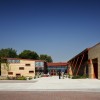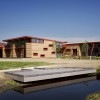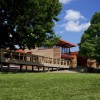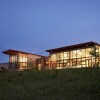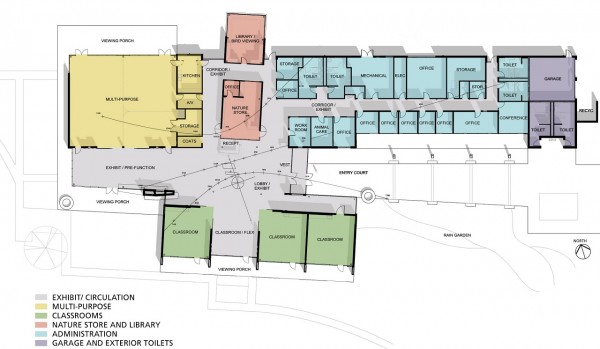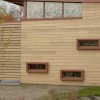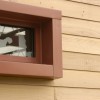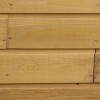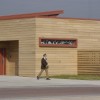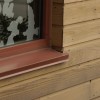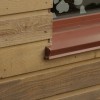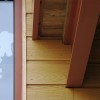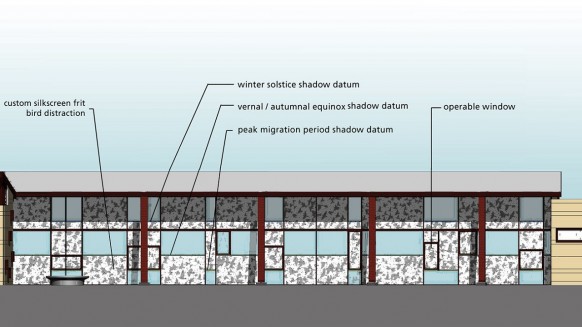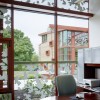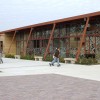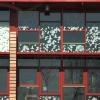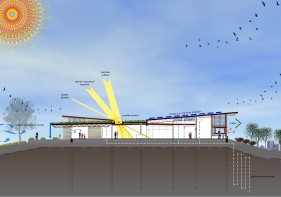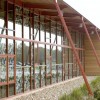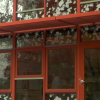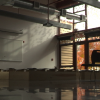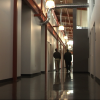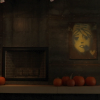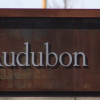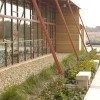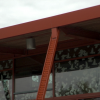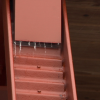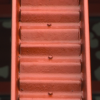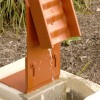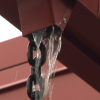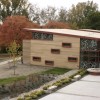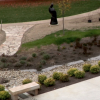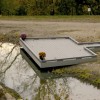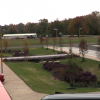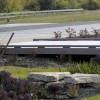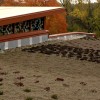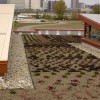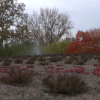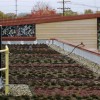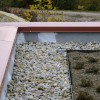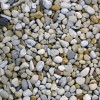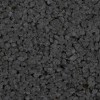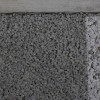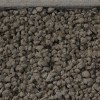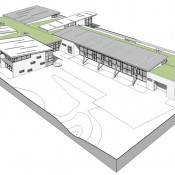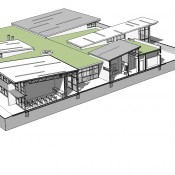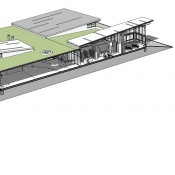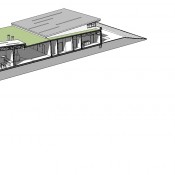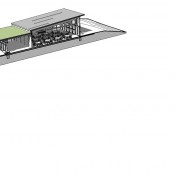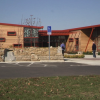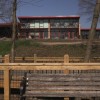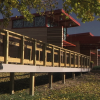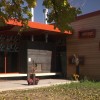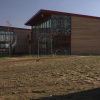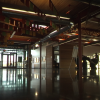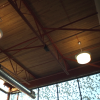Case Study: Grange Insurance Audubon Center
Video
The Grange Insurance Audubon Center exhibits several innovative systems and design approaches. DesignGroup architects introduced untreated cedar siding, custom storefront glazing to prevent bird strikes, exterior shading to achieve passive solar design, flexible classroom spaces, weathering steel signage, and geothermal wells with an integrated heat pump system. Following brownfield remediation, several stormwater management applications were constructed, including a vegetated roof, rain gardens, bioswales, and a pervious pavement parking lot. [Watch Part 2]
Project Overview
Project Overview
Audubon Center Quick Facts

- Opened: August 2009
- Building Area: 18,400 s.f.
- Construction Cost: $5.1 million
- Pursuing LEED Silver Certification.
- Energy Performance to exceed ASHRAE 90.1 standard by 56%.
- Water conserving measures will result in 48% less water usage.
- Annual energy savings expected to be $25,000.
- Minimal use of interior finishes reduce environmental impact, construction costs, and maintenance costs.
Project Team
- Client: Grange Insurance Audubon Center | Columbus Metro Parks
- Architect: DesignGroup
- Civil Engineer: Burgess & Niple
- MEP Engineer: Heapy Engineering
- Landscape Architect: Kinzelman Kline Gossman
- Structural Engineer: Shelley Metz Baumann Hawk
- Ecological Consultant: Williams Creek Consulting
- Owner's Representative: Miles-McClellan
- General Contractor: Gutknecht Construction

The Whittier Peninsula has long been an important site to Audubon of Ohio. Local Audubon Society members have been collecting data about migratory bird populations and their stops on the site for over 20 years. The site has been identified as part of an international program called “The Important Bird Area,” and its proximity to downtown aligns with the goal of the National Audubon Society’s 2020 Vision – a plan to locate new centers near urban districts across the United States in order to reach at least one in every four children for a visit to an Audubon Center.
In 2003, the City of Columbus, Columbus and Franklin County Metro Parks, and Audubon of Ohio began the planning for a new nature center and park. The City of Columbus would be responsible for the remediation of the land – cleaning up the brownfield after years of warehouses, concrete and asphalt production, and vehicular impound. The Columbus and Franklin County Metro Parks would develop the 84-acre Scioto Audubon Metropark. And Audubon would design, raise money for, build, and operate the center.
"This is one of the few urban ecology centers so close to a downtown district." Michael Bongiorno, Design Group
“There was an idea about placing these new urban education centers right downtown so that you could get more people involved in the mission,” says Heather Starck, Director of the Audubon Center. “Our mission is to connect people with the natural world. But we don’t want to stop there. We want to inspire stewardship in their everyday lives, so the direct and visual connection between downtown, where a lot of people live, and the natural area was really important for us when we looked at the architecture and where we would place the building on the site.”
Situated along the south edge of the property above a basin in the Scioto River, the new facility utilizes an ideal east-west axial orientation to maximize visual connections between downtown Columbus and the reclaimed natural environment. The design team nestled the center against the forest edge on the south and west sides to create more intimate spaces which draw visitors outside and connect them with nature. On the north side, dramatic glass walls absorb the views of downtown Columbus and overlook the expanding metro park. The placement of the building on the site is one of many design principles that reinforces the center's mission as both a place in which to learn and a place to learn from.
“This is one of the few urban ecology centers so close to a downtown district. We have downtown Columbus as a backdrop and we have the river’s edge and the tree line as sort of a highly naturalized setting, and so that creates a bit of tension, and we think it is a positive tension,” says Bongiorno, “We chose the materials of the building to reinforce that – the linear emphasis of the wood material contrasted with the metal and glass. It tells the story about the coexistence of the two, the urban and the natural.”
This story of coexistence is prominent in the entry procession, which becomes the initial classroom for studying water and light. Even on a dry day, slanted autumn orange downspouts, propped against a broad overhang, offer the opportunity to consider the movement of rainwater on the site. Benches and in-laid stones mark the channels that direct water beneath the entry court to the south-side rain garden. Flocks of birds, patterned on the glass, also prompt visitors to take a a closer look at the movement of light. Inset under the broad overhang, a south-facing composition of metal and glass integrates color-coded mullions to chart the seasonal movement of the sun.
“In addition to celebrating water, we are celebrating light. We wanted to really tell a story about what the sun did throughout the course of the day and throughout the course of the year," says Bongiorno.
The program for the Audubon Center includes classrooms, a multi-purpose room, bird viewing areas, a nature store, and administrative spaces. Each of these programmatic elements is enclosed in a cedar-clad volume and connected by a large open lobby and central exhibition space. This central space, sheltered by a vegetated roof, is an extension of the exterior, with south and west views aligned directly with the existing tree rows. To maximize spatial flexibility within a small footprint, large but lightweight sliding cedar barn doors provide access and privacy to the classrooms and multi-purpose room and offer the ability to enlarge the central lobby and exhibit space when open. The three indoor classrooms are located on the south side, with direct access to semi-private porch areas outside. An additional classroom is created outside on the southwest corner, anchored by a weathering steel clad fireplace on the porch and an existing 50'-0" mulberry tree at the center of a tree deck.
"From a programmatic level, we wanted a lot of flexibility in design. We didn’t want to have that big of a footprint. We wanted to minimize the space, but in order to do that, we needed to be flexible in all of our spaces," explains Starck.
The requirement for adaptable space informed the choice for the center's structural system, a steel frame system with an open web bar joist roof structure and tongue-and-groove roof deck. Degraded soils required a foundation design that includes 60'-0" deep piles supporting grade beams and a 12" structural slab on grade. As part of the sustainable approach, there is an economy of materials: the elements of the building's structure contribute to the interior palette. The structural concrete floor slab has been ground and polished to achieve an earthy, high-gloss finish, eliminating the need for additional finish flooring. The wood roof deck is both a structural and finish material, adding a warm, natural element inside. Accent materials on the welcome desk, casework, and furnishings were also chosen for their sustainable properties.

The theme for the Audubon Center is "Exploring the Nature of Change," influencing both the design process and the educational programming. Bongiorno and the design team deftly assembled a facility that posits the architecture itself to be center stage in the urban / natural drama. The passive solar design, on-site stormwater management, geothermal heat, and economy of materials animate the center and make it a living demonstration of conservation. And every day, classes and tours arrive at the center to discover their roles as active participants and stewards of the Audubon Center and the larger urban ecosystem.
Design Features
Design Features
A simple palette clads the exterior of the Audubon Center. Cedar, painted metals, and glass complete the primary set of materials, with weathering steel and limestone adding accent. The conventional materials are assembled in a unique composition that embodies the tension of the urban / natural site.
Cedar Siding
Chosen to emphasize the natural qualities of the site, cedar channel siding, installed horizontally, is the primary exterior cladding material. The FCS certified wood siding is 3/4" thick, has a 6" flat face, lapping to create a 1" channel. The naturally weather-resistant cedar is untreated so to allow the wood to change color over time.
Storefront Glazing | Custom Frit Pattern
In contrast to the natural cedar siding is the urban metal and glass of the storefront glazing system. While the system is standard, the composition is unique. Along the entry court, carefully proportioned segments subdivide the facade and demarcate the sun's position at the winter solstice, vernal and autumnal equinox, and peak migratory season with color-coded horizontal mullions. Specifically located panels are operable, allowing for natural ventilation of the building and decreasing the need for excess mechanical ventilation. A custom ceramic frit pattern was developed through studies of bird-friendly building guidelines to prevent bird strikes.
Passive Solar Design | Exterior Shading Devices
The design team utilized sun angle studies to determine where the shadow of the overhang would strike the glass. On the administrative wing, there is no direct summer sunlight into the building; rather it reflects off the light colored stones at the base of the building. The classrooms integrate both high, broad overhangs and intermediate shading shelves to minimize the heat of the summer sun. In the winter, the light enters deep into the classroom and administration spaces, helping to warm the building.
Classroom Flex Space
The classroom flex space, depending on the need, can be an exhibit space, reception space, or a fourth classroom learning space. It is separated from the classroom via barn-like sliding wood doors that provide flexibility of use and opportunities for varying levels of enclosure and privacy. Suspended direct / indirect fluorescent light features efficiently illuminate the space and highlight the exposed wood roof deck ceiling above. Step outside onto the viewing porch to see the slatted aluminum sunscreens that control solar heat gain and provide a sense of enclosure and scale. The angled slats prevent snow buildup and facilitate air movement.
Weathering Steel
Weathering steel is used as an accent material at the Audubon Center. This special steel, a primary material of the project sign, is designed to patina with continued exposure to weather. Indoor and outdoor fireplaces also employ weathering steel cladding to create a focal anchor at the west end of the classroom wing.
Geothermal Wells and Heat Pump System
While the Audubon Center incorporates many passive solar and energy-efficiency design elements, the need for heating and cooling in the Ohio climate is not eliminated. A system of 27 geothermal wells, over 300 feet deep, connects to a ground source heat pump to provide the main heating and cooling for the facility. The choice of geothermal heat sustains both the center's mission of conservation and the long-term energy costs. “A system that allows us to use less fossil fuels is an important thing. It’s going to save us $25,000-$30,000 per year on heating and cooling costs, so it is a good economic decision as well," explains Starck. Read more about geothermal heat pump systems.
Stormwater Management
Stormwater Management
On-site stormwater management was a primary focus during the design of the Audubon Center. “We needed to make a strong statement about how we were managing our water. We challenged our architects. We said ‘We want to manage all of our stormwater, but we also want you to show everyone how we’re managing our stormwater,’” explains Starck. The site's location as a migratory bird stop along the Scioto River required sensitive design and engineering to protect the existing river basin and created wetlands of the park. The architect, civil engineer and landscape architects responded with a facility that manages all of its stormwater on site, without releasing run-off into the Scioto River, and demonstrates a few ways that this is accomplished.
Entry Court Downspouts
The entry court downspouts are steel channels with a corrugated metal insert sloped at 60 degrees. This design allows the water to drain from the roof at a slower rate than a vertical downspout. The placement of these downspouts along the north side of the entry court serves as the first demonstration to the visitors as to how the stormwater is managed. A rain chain that slows falling water from the downspout anchors the south side of the entry court.
Rain Gardens and Bioswales
In addition to the artistic downspouts, the entry court of the Audubon Center also features the primary rain garden on site. The rain garden cleanses the water coming off the roof areas and acts as a buffer to the overflow stormwater retention area. Bioswales divide the parking lot channel and absorb stormwater, offsetting the impervious areas of the site.
Vegetated Roof
The Audubon Center features two primary roof systems - a membrane roof and a vegetated roof. The vegetated roof system consists of native phlox and sedum planted in a shallow, lightweight soil similar to pea gravel, over a root barrier. The net-like root barrier is a membrane which allows the roots to take hold in the soil, but not to penetrate the waterproof membrane of the roof deck. A waterproof membrane covers the deck insulation and wood deck structure. With a slight slope to the south and north edges, the vegetated roof absorbs rain water and releases excess water in a more controlled manner.
Pervious Pavement
Pervious pavement is a green, sustainable strategy that can assist in lowering stormwater runoff, naturally decreasing automobile pollutants, recharging the water table supply and moderating the heat island effect. Similar to other complex construction systems, in order for the sustainable pavement to perform as it was designed, it needs to be installed with precision and maintained with a high level of vigilance. To drain water effectively on any given site, different geographical areas require special adjustments to the technology as well. Read more about pervious pavement.
Photo Gallery
Photo Gallery
Exterior
Interior
Cedar Siding
Storefront Glazing | Custom Frit Pattern
Passive Solar Design | Exterior Shading Devices
Classroom Flex Space
Weathering Steel
Entry Court Downspouts
Rain Gardens and Bioswales
Vegetated Roof

